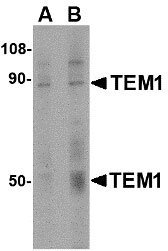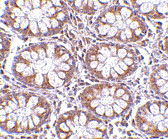TEM1 Antibody
- 产品详情
- 实验流程
- 背景知识
Application
| WB, IF, E, IHC-P |
|---|---|
| Primary Accession | Q9HCU0 |
| Other Accession | NP_065137, 9966885 |
| Reactivity | Human, Mouse, Rat |
| Host | Rabbit |
| Clonality | Polyclonal |
| Isotype | IgG |
| Calculated MW | 80859 Da |
| Concentration (mg/ml) | 1 mg/mL |
| Conjugate | Unconjugated |
| Application Notes | TEM1 antibody can be used for detection of TEM1 by Western blot at 0.5 - 1 µg/mL. Antibody can also be used for immunohistochemistry starting at 2.5 µg/mL. For immunofluorescence start at 20 µg/mL. |
| Gene ID | 57124 |
|---|---|
| Other Names | Endosialin, Tumor endothelial marker 1, CD248, CD248, CD164L1, TEM1 |
| Target/Specificity | CD248; At least two isoforms of TEM1 are known to exist; this antibody recognizes both isoforms. |
| Reconstitution & Storage | TEM1 antibody can be stored at 4℃ for three months and -20℃, stable for up to one year. As with all antibodies care should be taken to avoid repeated freeze thaw cycles. Antibodies should not be exposed to prolonged high temperatures. |
| Precautions | TEM1 Antibody is for research use only and not for use in diagnostic or therapeutic procedures. |
| Name | CD248 |
|---|---|
| Synonyms | CD164L1, TEM1 |
| Function | Cell surface glycoprotein involved in various biological processes including angiogenesis, immune response modulation, and tissue remodeling and repair. Participates in pericyte proliferation through positive modulation of the PDGF receptor signaling pathway (PubMed:20484976). Acts as a scaffold for factor X, triggering allosteric changes and the spatial re-alignment of factor X with the TF-factor VIIa complex, thereby enhancing coagulation activation. Modulates the insulin signaling pathway by interacting with insulin receptor/INSR and by diminishing its capacity to be autophosphorylated in response to insulin. Also regulates LPS-induced inflammatory response in macrophages by favoring the production of proinflammatory cytokines. In human, negatively regulates T-cell proliferation compared with stromal cells where it increases proliferation (PubMed:21466550). |
| Cellular Location | Membrane; Single-pass type I membrane protein |
| Tissue Location | Expressed in tumor endothelial cells but absent or barely detectable in normal endothelial cells. Expressed in metastatic lesions of the liver and during angiogenesis of corpus luteum formation and wound healing. Expressed in vascular endothelial cells of malignant tumors but not in normal blood vessels. Expressed in stromal fibroblasts. Strongly expressed in pericytes (PubMed:20484976) Expressed on stromal cells and cells with lymphoid morphology such a T- cells (PubMed:21466550). |
For Research Use Only. Not For Use In Diagnostic Procedures.
Provided below are standard protocols that you may find useful for product applications.
BACKGROUND
TEM1 Antibody: Tumor endothelial marker (TEM) 1 was originally identified as a human embryonic fibroblast-specific antigen and was later determined to be endosialin, a single-pass transmembrane glycoprotein that has multiple extracellular domains, including three EGF-like domains, a sushi-like domain, and a C lectin-like domain. TEM proteins are significantly up-regulated during angiogenesis and neoangiogenesis that are crucial for the growth of solid tumors. While TEM1 is not required for angiogenesis during fetal development, postnatal growth or wound healing, it plays a role in tumor growth, invasion, and metastasis. Fibronectin and collagen types I and IV act as specific ligands of TEM1, leading to suggestions that these molecules may cause changes in the extracellular matrix, cell adhesion and migration during tumor invasion.
REFERENCES
Rettig WJ, Garin-Chesa P, Healey JH, et al. Identification of endosialin, a cell surface glycoprotein of vascular endothelial cells in human cancer. Proc. Natl. Acad. Sci. USA 1992; 89:10832-6.
Christian S, Ahorn H, Koehler A, et al. Molecular cloning and characterization of endosialin, a C-type lectin-like cell surface receptor of tumor endothelium. J. Biol. Chem. 2001; 276:7408-14.
Nanda A and St Croix B. Tumor endothelial markers: new targets for cancer therapy. Curr. Opin. Oncol. 2004; 16:44-9.
Nanda A, Karim B, Peng Z, et al. Tumor endothelial marker 1 (TEM1) functions in the growth and progression of abdominal tumors. Proc. Natl. Acad. Sci. USA 2006; 103:3351-6.
终于等到您。ABCEPTA(百远生物)抗体产品。
点击下方“我要评价 ”按钮提交您的反馈信息,您的反馈和评价是我们最宝贵的财富之一,
我们将在1-3个工作日内处理您的反馈信息。
如有疑问,联系:0512-88856768 tech-china@abcepta.com.























 癌症的基本特征包括细胞增殖、血管生成、迁移、凋亡逃避机制和细胞永生等。找到癌症发生过程中这些通路的关键标记物和对应的抗体用于检测至关重要。
癌症的基本特征包括细胞增殖、血管生成、迁移、凋亡逃避机制和细胞永生等。找到癌症发生过程中这些通路的关键标记物和对应的抗体用于检测至关重要。 为您推荐一个泛素化位点预测神器——泛素化分析工具,可以为您的蛋白的泛素化位点作出预测和评分。
为您推荐一个泛素化位点预测神器——泛素化分析工具,可以为您的蛋白的泛素化位点作出预测和评分。 细胞自噬受体图形绘图工具为你的蛋白的细胞受体结合位点作出预测和评分,识别结合到自噬通路中的蛋白是非常重要的,便于让我们理解自噬在正常生理、病理过程中的作用,如发育、细胞分化、神经退化性疾病、压力条件下、感染和癌症。
细胞自噬受体图形绘图工具为你的蛋白的细胞受体结合位点作出预测和评分,识别结合到自噬通路中的蛋白是非常重要的,便于让我们理解自噬在正常生理、病理过程中的作用,如发育、细胞分化、神经退化性疾病、压力条件下、感染和癌症。








